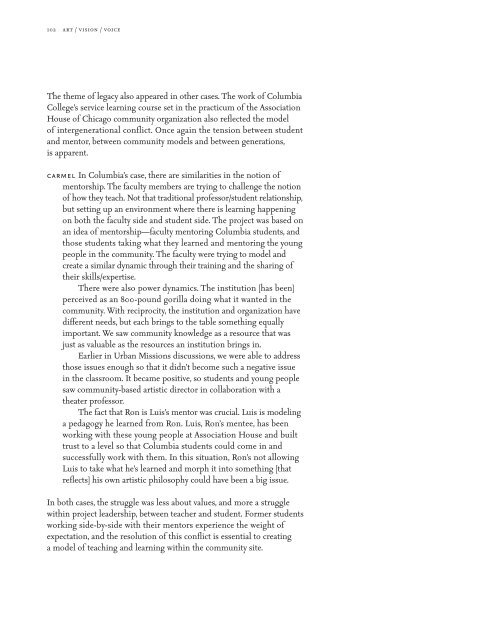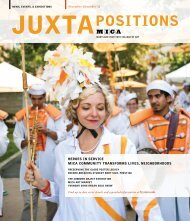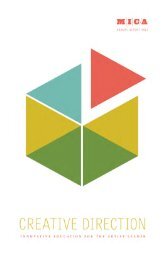art/vision/voice - Maryland Institute College of Art
art/vision/voice - Maryland Institute College of Art
art/vision/voice - Maryland Institute College of Art
You also want an ePaper? Increase the reach of your titles
YUMPU automatically turns print PDFs into web optimized ePapers that Google loves.
102 <strong>art</strong> / <strong>vision</strong> / <strong>voice</strong><br />
The theme <strong>of</strong> legacy also appeared in other cases. The work <strong>of</strong> Columbia<br />
<strong>College</strong>’s service learning course set in the practicum <strong>of</strong> the Association<br />
House <strong>of</strong> Chicago community organization also reflected the model<br />
<strong>of</strong> intergenerational conflict. Once again the tension between student<br />
and mentor, between community models and between generations,<br />
is apparent.<br />
carmel In Columbia’s case, there are similarities in the notion <strong>of</strong><br />
mentorship. The faculty members are trying to challenge the notion<br />
<strong>of</strong> how they teach. Not that traditional pr<strong>of</strong>essor/student relationship,<br />
but setting up an environment where there is learning happening<br />
on both the faculty side and student side. The project was based on<br />
an idea <strong>of</strong> mentorship—faculty mentoring Columbia students, and<br />
those students taking what they learned and mentoring the young<br />
people in the community. The faculty were trying to model and<br />
create a similar dynamic through their training and the sharing <strong>of</strong><br />
their skills/expertise.<br />
There were also power dynamics. The institution [has been]<br />
perceived as an 800-pound gorilla doing what it wanted in the<br />
community. With reciprocity, the institution and organization have<br />
different needs, but each brings to the table something equally<br />
important. We saw community knowledge as a resource that was<br />
just as valuable as the resources an institution brings in.<br />
Earlier in Urban Missions discussions, we were able to address<br />
those issues enough so that it didn’t become such a negative issue<br />
in the classroom. It became positive, so students and young people<br />
saw community-based <strong>art</strong>istic director in collaboration with a<br />
theater pr<strong>of</strong>essor.<br />
The fact that Ron is Luis’s mentor was crucial. Luis is modeling<br />
a pedagogy he learned from Ron. Luis, Ron’s mentee, has been<br />
working with these young people at Association House and built<br />
trust to a level so that Columbia students could come in and<br />
successfully work with them. In this situation, Ron’s not allowing<br />
Luis to take what he’s learned and morph it into something [that<br />
reflects] his own <strong>art</strong>istic philosophy could have been a big issue.<br />
In both cases, the struggle was less about values, and more a struggle<br />
within project leadership, between teacher and student. Former students<br />
working side-by-side with their mentors experience the weight <strong>of</strong><br />
expectation, and the resolution <strong>of</strong> this conflict is essential to creating<br />
a model <strong>of</strong> teaching and learning within the community site.
















